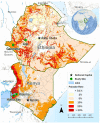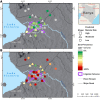Impact of Environmental Modifications on the Ecology, Epidemiology, and Pathogenesis of Plasmodium falciparum and Plasmodium vivax Malaria in East Africa
- PMID: 36228918
- PMCID: PMC9662213
- DOI: 10.4269/ajtmh.21-1254
Impact of Environmental Modifications on the Ecology, Epidemiology, and Pathogenesis of Plasmodium falciparum and Plasmodium vivax Malaria in East Africa
Abstract
Food insecurity, recurrent famine, and poverty threaten the health of millions of African residents. Construction of dams and rural irrigation schemes is key to solving these problems. The sub-Saharan Africa International Center of Excellence for Malaria Research addresses major knowledge gaps and challenges in Plasmodium falciparum and Plasmodium vivax malaria control and elimination in malaria-endemic areas of Kenya and Ethiopia where major investments in water resource development are taking place. This article highlights progress of the International Center of Excellence for Malaria Research in malaria vector ecology and behavior, epidemiology, and pathogenesis since its inception in 2017. Studies conducted in four field sites in Kenya and Ethiopia show that dams and irrigation increased the abundance, stability, and productivity of larval habitats, resulting in increased malaria transmission and a greater disease burden. These field studies, together with hydrological and malaria transmission modeling, enhance the ability to predict the impact of water resource development projects on vector larval ecology and malaria risks, thereby facilitating the development of optimal water and environmental management practices in the context of malaria control efforts. Intersectoral collaborations and community engagement are crucial to develop and implement cost-effective malaria control strategies that meet food security needs while controlling malaria burden in local communities.
Figures





Similar articles
-
A retrospective analysis on the transmission of Plasmodium falciparum and Plasmodium vivax: the case of Adama City, East Shoa Zone, Oromia, Ethiopia.Malar J. 2019 Jun 11;18(1):193. doi: 10.1186/s12936-019-2827-6. Malar J. 2019. PMID: 31185977 Free PMC article.
-
Five years following first detection of Anopheles stephensi (Diptera: Culicidae) in Djibouti, Horn of Africa: populations established-malaria emerging.Parasitol Res. 2019 Mar;118(3):725-732. doi: 10.1007/s00436-019-06213-0. Epub 2019 Jan 22. Parasitol Res. 2019. PMID: 30671729
-
Enhancing Malaria Research, Surveillance, and Control in Endemic Areas of Kenya and Ethiopia.Am J Trop Med Hyg. 2022 Oct 11;107(4_Suppl):14-20. doi: 10.4269/ajtmh.21-1303. Print 2022 Oct 11. Am J Trop Med Hyg. 2022. PMID: 36228905 Free PMC article.
-
Malaria epidemiology and interventions in Ethiopia from 2001 to 2016.Infect Dis Poverty. 2018 Nov 5;7(1):103. doi: 10.1186/s40249-018-0487-3. Infect Dis Poverty. 2018. PMID: 30392470 Free PMC article. Review.
-
[Role of primaquine in malaria control and elimination in French-speaking Africa].Bull Soc Pathol Exot. 2017 Aug;110(3):198-206. doi: 10.1007/s13149-017-0556-z. Epub 2017 Apr 17. Bull Soc Pathol Exot. 2017. PMID: 28417346 Review. French.
Cited by
-
Impact of Climate Change on the Global Dynamics of Vector-Borne Infectious Diseases: A Narrative Review.Cureus. 2025 Jan 25;17(1):e77972. doi: 10.7759/cureus.77972. eCollection 2025 Jan. Cureus. 2025. PMID: 39996198 Free PMC article. Review.
-
Higher outdoor mosquito density and Plasmodium infection rates in and around malaria index case households in low transmission settings of Ethiopia: Implications for vector control.Parasit Vectors. 2024 Feb 6;17(1):53. doi: 10.1186/s13071-023-06088-2. Parasit Vectors. 2024. PMID: 38321572 Free PMC article.
-
PvGAP: Development of a globally-applicable, highly-multiplexed microhaplotype amplicon panel for Plasmodium vivax.medRxiv [Preprint]. 2025 May 2:2025.04.30.25326751. doi: 10.1101/2025.04.30.25326751. medRxiv. 2025. PMID: 40343030 Free PMC article. Preprint.
-
Bionomics of Anopheles stephensi across the urban-rural landscapes of Eastern Ethiopia.Malar J. 2025 Aug 23;24(1):274. doi: 10.1186/s12936-025-05527-y. Malar J. 2025. PMID: 40849467
References
-
- Sanchez-Ribas J, Parra-Henao G, Guimaraes AE, 2012. Impact of dams and irrigation schemes in Anopheline (Diptera: Culicidae) bionomics and malaria epidemiology. Rev Inst Med Trop São Paulo 54: 179–191. - PubMed
-
- Keiser J, De Castro MC, Maltese MF, Bos R, Tanner M, Singer BH, Utzinger J, 2005. Effect of irrigation and large dams on the burden of malaria on a global and regional scale. Am J Trop Med Hyg 72: 392–406. - PubMed
-
- Marcella MP, Eltahir EAB, 2014. Introducing an irrigation scheme to a regional climate model: a case study over West Africa. J Clim 27: 5708–5723.
-
- Sinyolo S, Mudhara M, Wale E, 2014. Water security and rural household food security: empirical evidence from the Mzinyathi District in South Africa. Food Secur 6: 483–499.

